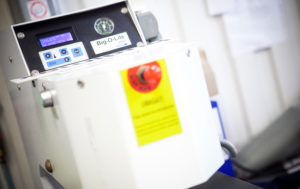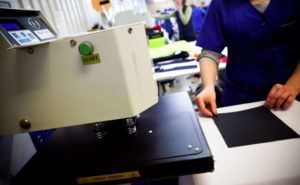Thermal transfer printing technology: what is it and how to use it?
Thermal transfer printing enjoys growing popularity among companies for which protective clothing, apart from performing typically protective and safety functions, must also meet appropriate image-related standards.
Thermal transfer, also called thermal printing, is a method which consists in hot-stamping of an imprint prepared beforehand, using high pressure and temperature for a set time. A proper selection of these three parameters enables a broad range of applications of this technology and its greatest advantage is the ability to make imprints on fabrics. A broad range of colours, numerous different applications, uncomplicated use and durability caused companies to more and more willingly use thermal transfer technologies in visual identification processes.

Spis treści
ToggleThermal transfer foils
An important part of know-how in the production of clothing marked using the thermal transfer technology is the selection of foils for printing, which depends on protective parameters and the type and structure of the fabric. Thermal imprints are made on dedicated components which facilitate the placing of imprints on fabrics in a correct position thanks to their gluing features. Thermal transfer foils consist of the main material and a transparent, usually slightly sticky, transport base. Flame retardant and reflective flock and flex foils are usually used for marking work clothing and personal protective equipment.

Flex foils have a very large range of colours. Imprints made using these foils are very smooth, relatively rigid, durable and resistance to repeated washing. Marking made using this foil type gives a matte or gloss effect.
On the other hand, with the flock foil, covered by a textile fleece, we obtain a velvety imprint whose appearance resembles suede or velour. Their foil structure and a special coating makes the marking definitely thicker, thanks to which it can be also made on polyester and acrilic fibres. On the other hand, the flock foil colour range is more limited.
We also very often use flame retardant and reflective foils for marking protective clothing. These foils not only make the appearance of the imprints more attractive, but also cause the additional marking to increase employee visibility and perform additional protective functions. Thorough testing and selection of the appropriate carrier base is also very important in the case of flame retardant and reflective foils. This determines whether the imprint will be resistant to various weather conditions and whether it will retain its original appearance.
Use of the thermal transfer technology
Thermal transfer is a relatively simple and durable method of marking clothing, but it would be very difficult to make permanent marking without specialised knowledge and technically advanced machinery. This method is perfect for both marking clothing elements in the manufacturing process and for putting wordmarks on ready textile products with an irregular shape and hard to reach areas, such as caps, backpacks, bags, scarves, and vests. Thanks to the varied thermal transfer technology, computer controlled tools and experienced staff we can offer our clients customised clothing collections, enriched by professional imprints which are an important element of building visual identification of every company.
Advantages of thermal transfer:
- quick to prepare,
- high accuracy in imprint reproduction,
- ability to reproduce small elements,
- high quality of the imprinted graphics,
- variety of bases used – cotton, polyester, knit,
- high durability and flexibility of the imprint.



